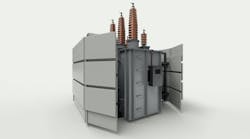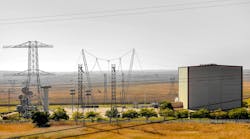In late 2022, two attacks on electrical substations made the news. One was on the West Coast near Tacoma, Washington; the other was across the country in Moore County, North Carolina. Both left thousands stranded without power in winter. As these incidents imply, physical attacks on the power grid are widespread. According to the Department of Energy (DOE), 2022 saw a 77% increase in power grid attacks compared to 2021. Unfortunately, this increase has continued — the first quarter of 2023 showed twice the number of attacks as the first quarter of 2022, according to the DOE.
With this data in mind, utilities may find in their required 30- and 60-month security reevaluations that more substations need physical security measures or protection that goes beyond wall structures. While walls provide some degree of protection, they must be placed at a distance from the equipment they protect, which reduces their effectiveness against ballistic attacks, especially from above. However, there are systems utilities can utilize to mitigate their equipment’s vulnerability.
Newly available modular or panel-based ballistic barrier systems provide more robust physical protection. Developed collaboratively between security and utility communities, these systems protect without compromising day-to-day operation—including guarding against fire and other emerging threats. In addition, being lightweight, they deploy quickly and without the need to obtain permits to dig foundations. Readily adaptable, these ballistic barrier systems can surround energy transmission equipment of any size and dimension, including large high voltage transmission transformers. Such flexibility is important given that equipment size, shape and location constraints vary greatly between substations.
Further, when these ballistic barriers incorporate automatic detection and notification technology, they can provide additional levels of physical security. By adopting these next-generation, panel-based ballistic barrier systems, utilities can meet their present physical security needs while also leaving potential for future growth, including more stringent security recommendations from agencies that enforce North American Electric Reliability Corporation’s critical infrastructure protection standards (NERC CIP014).
Current State of the Power Grid
Many of the country’s over 55,000 substations are visible behind chain link fences and located near neighborhoods and businesses. In addition to the sheer number of electrical substations, location particulars (such as terrain, output need, climate and more) broadens the range of design variation, which complicates building a “one-size-fits-all” security solution. The number of critical substations is likely to increase with higher demands for electricity.
Higher demands also demonstrate another facet of power grid security: transformer shortage. Not only has the cost of transformers increased significantly over the past three years, but the lead times for procuring components are often well over a year. The shortage affects utilities that experience ballistic attack since repair or replacement can be delayed. These considerations underscore that timing is important to enhancing the overall resiliency of the nation’s power grid.
Panel-based Systems
In the past, guarding against physical attack often meant deploying large wall systems made from steel, concrete or other like materials. Unfortunately, the application of these structures is limited as is their effectiveness against today’s threats. Further, they usually require a large footprint with deep foundations, which could slow their construction or preclude their use entirely.
Alternately, panel-based ballistic protection systems address current and emerging threats by being able to immediately surround equipment on all sides, regardless of size or location constraints. Their modularity also allows for individually tailored designs to accommodate most substation layouts. In addition, these systems can be deployed on select sides of individual transformers to mitigate damage from neighboring equipment experiencing catastrophic failure—no matter if it is caused by attacks, system malfunction or fire.
Likewise, the system’s lightweight components do not require deep foundations, dramatically shortening installation timelines. This also solves challenges inherent in construction around established equipment, such as obtaining soil surveys, digging permits, risking damage to buried cables and more. Further, their composite construction not only absorbs bullets and blast fragmentation but also exhibits thermal barrier properties. This helps manage the effects of extreme temperatures on equipment reducing strain while improving performance and extending equipment service life.
Finally, panel-based ballistic protection systems reduce vulnerability immediately following a ballistic event due to their modular construction. These panels are quick and easy to replace if damaged. This can help speed the re-establishment of physical protection and is far more cost effective when compared to repair of traditional wall structures.
Modularity also helps to reduce overall lifecycle costs associated with most physical security systems. Panel-based systems are also compatible with substation operation by design, consequently individual panels can be easily removed by utility professionals when performing diagnostics, maintenance or other day-to-day operations.
Automatic Detection and Notification
Part of protecting against ballistic attack is shielding vulnerable equipment from projectiles and explosions. Another priority is preventing future attacks by apprehending those responsible. The majority of power grid attacks remain unsolved—as is the case with Moore County. When perpetrators evade arrest, not only are they free to attack again, but it also sends a message that these crimes can be undertaken without risk. Apprehending attackers quickly can prevent future attacks and deter others.
The difficulty in finding and bringing those responsible to justice is two-fold. First, many attacks involve high-powered rifles, which can allow shooters to be far removed from their targets. Given that many substations are visible beyond existing wall structures or through chain-link fences, shooters have several potential attack positions and access to multiple escape routes. Second, because substations can be remote or strategically placed out of sight, there may be few options for surveillance beyond the perimeter, which increases the likelihood of an attacker evading arrest.
When ballistic protection incorporates energy-wave detection technology, it can solve both difficulties. This highly accurate technology can recognize and analyze ballistic attacks and determine the direction from which shots were fired. It can also autonomously notify first responders and dispatch robotics such as surveillance drones or articulating cameras—all within seconds of a ballistic event and without human intervention. This allows first responders to know the occurrence, location and direction of an attack or explosion without having to investigate the site first, providing valuable time and safety when pursuing those responsible. Both capabilities can act as a powerful deterrent to future attacks.
Going Beyond Local Protection
It is crucial to note that the U.S. power grid is interconnected, meaning these attacks can have widespread consequences. According to Brian Harrell, a former U.S. Department of Homeland Security Assistant Secretary for Infrastructure Protection, a coordinated attack on just a few systems could create a domino effect, leaving large swathes of the country without power.
As such, protecting utilities goes beyond ensuring local communities have electrical power. It is also critical to the entire nation. Next-generation ballistic protective systems can support hardening critical infrastructure today and in the future. These systems can be easily tailored to individual substation layouts and deployed quickly since they do not require foundations and are readily customizable. They guard against ballistic attack, fire and other emerging threats. Detection systems can assist law enforcement with the apprehension of those responsible to potentially reduce future attacks. All these qualities can help utilities become more resilient, which in turn helps keep the individuals and businesses that rely on them safer.
Jeffrey Isquith is the founder and CEO of Amulet Protective Technologies and Amulet Critical Infrastructure—an engineering, design and manufacturer of innovative physical security solutions to protect life and property from ballistic violence. Drawing significant experience from his roles in project management with the military support divisions of Honeywell and General Electric corporations, he has introduced an entirely new approach to physical security of public environments and is an active member of the Security Industry Association.


